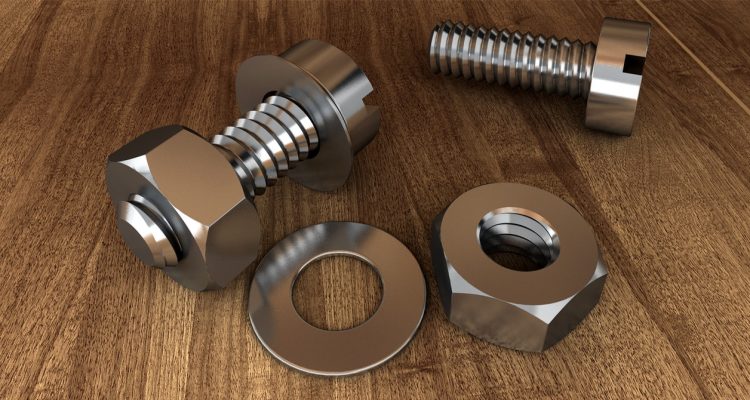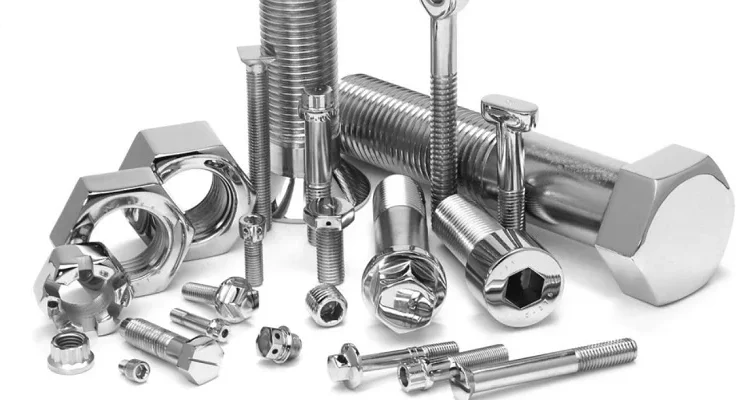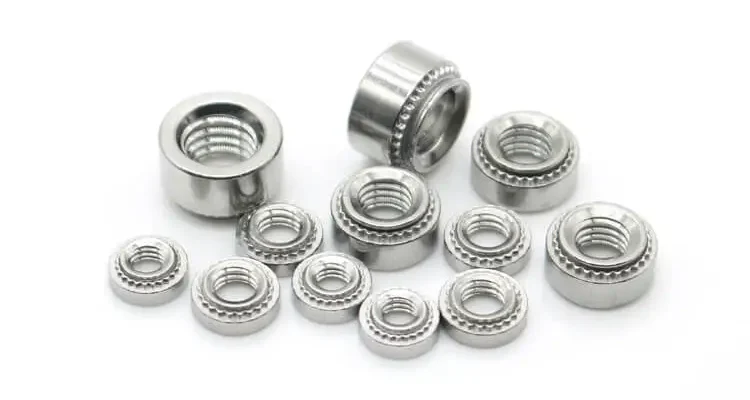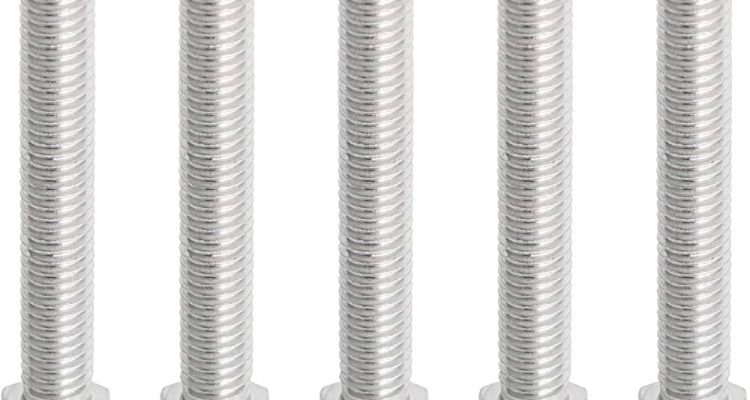
5 Differences Between Bolts and Screws
Bolts are paired with nuts and require a wrench for tightening, whereas screws are self-tapping, tightened by a screwdriver. Bolts distribute load across parts; screws are for direct material attachment
Definition Differences
Understanding the essential difference between bolts and screws is vital when selecting a fastener for a given project. Let’s investigate the exact definitions of these two types of fasteners to understand what differentiates them.
Bolts: Made for Heavy-Duty Application
Bolt is “a type of threaded fastener” that is “externally threaded and is designed for insertion through holes in assembled parts, (Rudnev 598)”. The most characteristic detail about bolts is that their installation is only possible with the use of another fastener, namely, a nut. As Rudnev states, bolts “are not screwed directly into the member but are inserted through holes and clamped into position by means of a nut holding the member, (598)”. For instance, in the construction of bridges, extremely powerful bolts are utilized to attach the girders to the columns. These bolts need to be powerful to withstand the overload and vibrations which are so crucial in construction.
Screws: Versatile and Independent
In contrast, it is logical to infer that screws are defined as “externally threaded fasteners ” that do not need any other bolt to be attached to, and can “be inserted directly into materials, the head of the fastener being so formed that it can be torqued to tighten or loosen it, (Rudnev 598)”. For example, screws are frequently used in the furniture because they can be screwed directly into wood and other light material to attach two pieces directly to each other.
Applications
In other words, instead of attaching two materials in high-stress, bolted connections which are utilized in building construction and machinery, according to Rudnev, one should use screws when high stress is not a problem, and “the internal thread (or self-threading ) is must be formed”, meaning that the main application area is woodworking and many applications in the consumer electronics where frequent disassembly is required. Simultaneously, the internal thread is impossible to form in the engine compartments, which is why bolts are employed for engine assembly, where high stress is expected. Instead, bear in mind that the screws are used in the cabin fixtures and cabin assemblies, as the components need to be replaced or adjusted.

What’s the Difference between Bolts and Screws
Usage
The choice between a bolt and a screw depends largely on the nature of the application and the required durability of the joint. Understanding these usage contexts helps in selecting the appropriate fastener, ensuring both the functionality and longevity of the assembled product.
Bolts: Securing Structural Integrity
Bolts are used in applications that require a strong, enduring joint. They are attached to a nut and do not tap themselves to connect with materials. In construction, bolts are used to attach steel beams in buildings such as skyscrapers or bridges. As an example, a bolt together with a washer and nut may attach the girder to the bridge’s pillar, and each beam is tagged with a bolt in such capacity. The structure can be exposed to the overall environmental stresses and loads; thus, ensuring that the components are securely connected is vital for structural safety.
In automotive, bolts are used to attach the engine block since the bolts there need to maintain integrity under high temperatures and vibrations. The engine would eventually deteriorate and collapse without secure bolts. Therefore, they are torqued to specific standards set by the car’s manufacturer.
Screws: Flexible and Contained Fastening
Screws are highly popular in industrial and domestic uses due to the ease of usage and application. They are convenient to connect with the materials and are versatile in different uses. Screws can be used to drill into the material or connect with an existing thread of the material. In housing construction, screws are the preferable method of attachment of furniture and ceremonial wood. For example, the most appropriate approach of connecting the wall cabinets to the wall studs would be to drill them with wood screws. There is no need to insert the nut when being able to drill into the wood and have it securely attached to the wall. In electronics, the traffic controller machines or the personal computers have screws to connect the devices since they require intense and constant maintenance or upgrades. The innumerable screws in a computer allow a pleasant and simple access for ample maintenance.
Line Styles and Assembly
From the process of installation alone, the difference in line styles and assembly techniques between bolts and screws embody their nature of ideal application, which compliments the whole assembly process efficiency.
Bolts: Standard Threads for Heavy Application
First, bolts often feature a standard thread pattern which mirrors with the correct nuts of the same size and thread outline. The threads have been built for the highest strength and durability and utilised for heavier applications. In construction, when building a steel frame, for example, the bolts would utilise a generally llamado thread, such as the Unified National Coarse . This design boasts of excellent load distribution capabilities for given connections. Moreover, since maximum bolt tension must be maintained, each bolt must be perfectly torqued.
In assembly, it would take three separate steps to have a secure connection:
The bolt is first slotted into the pre-drilled hole.
The nut is placed in the opposite socket end and lightly tightened by hand until the next step.
The final step requires a wrench or socket to apply final torque along a required torque pattern to similarly distribute the load, especially vital in engines, gears, and aerospace structure assembly.
Screws: Many Threads for Many Needs
Screws, unlike bolts have many thread styles which best suit the material it enters. Wood screws, with sharp and wide thread roots can bite into the wood and slot in directly without pre-drilling into it. Other threads such as sheet screws have threads much finer than even wood screws but can be used to tap firmly into metala. In actual application, screws are often used when the installation must accommodate managed assembly and disassembly. In construction – particularly furniture assembly – screws are used to piece parts together to pack and ship. The installation process, therefore, involves:
Pre-selection of the fitting screw type for the material.
Only if not-prepared, pre-drilling a small hole called a pilot hole for the body.
Pushing the screw through the pilot hole directly through the material, or through tomorrow using a screwdriver or power drill for the flitterhead.
Applicable Scene
These examples illustrate the context-specific use of each type of fastener, allowing engineers to tailor the best approach depending on the application’s specific needs, whether in terms of strength, functionality, or ease of assembly.
Bolts: Best for Structural Applications
Bolts are used in projects that require the utmost care in terms of structural integrity and must be able to accept the highest amount of stress or load. In the construction of major buildings and infrastructures, for example, bolts are the best solution for the purpose, as they can provide the needed strength and reliability. Typically, this involves the use of high-strength steel bolts to fasten the steel beams that make up the frame of high rises. The process involves:
Positioning the beams.
Drilling holes through them to match the holes in the connecting material.
Inserting the bolt and, on the other side of the beam, tightening a nut and a washer.
The nut is then tightened to the correct torque specifications using a torque wrench.
In this regard, the joint will still be able to accept dynamic loads and vibrations without breaking or separating the attached materials.
Similarly, bolts are used in the automotive industry to fasten the components of the engine, avoiding the consequences of potential failure such as engine explosions. The steps are similar to the ideal use example:
Aligning the holes in the engine block and the components.
Securing the beam into place, to which the other component attaches.
Respecting the torque settings provided by the manufacturer, which will ensure that the components do not separate under high pressure or temperature.
Screws: Best for Consumer and Internal Applications
Screws are used in relatively lighter and less critical applications where assembly needs to be highly precise and performed with simple tools. In home improvement projects such as furniture assembly or the installation of kitchen cabinets, screws are frequently the best choice, fastening the two pieces together quickly and with a great deal of tightening. The typical steps include:
Choosing the right screw.
If necessary, making pilot holes in the materials to prevent splitting.
- Drilling the wood screws into the material and the form, securing the parts or the furniture on the wall.
In a similar vein, the fasteners are employed in the assembly and maintenance of consumer electronics, such as laptops and smartphones, where they allow easy disassembly and access to the interior:
Removing the screws from the casing with small screwdrivers.
Separating the form.
Reassembling the device, inserting and tightening the screws without damaging the sensitive electronic components.

What is the Difference between Bolt and Screw
Standards and Specifications
They are as crucial as follows since they consider features and specifications that make them standardized for compatibility and safety for where they are put into use.
Bolts: Unified and Metric Thread Standards
To make sure that a bolt will not break when put under load, it should be made under a set of standards that consider the anticipated load and stress that these bolts or screws will go through. The two common standards are Unified Thread Standard or UTS, and Metric Thread Standard. When it comes to applications, structural bolts that are used in construction are held against the ASTM A325, which is the standard closest to safety and mechanical properties. The size of these steel bolts range from 1/2 inch to 1-1/2 inches in diameter.
The steps taken to choose a bolt and its use are as follows:
- The load and environmental condition of an application are taken into account to choose the right bolt.
- The bolt should meet the strength and size of the required needs.
- The bolt combination and washers should be suitable for the material and structural demands.
For industries like aerospace, bolts can be further held by a set of standards, particularly given by the SAE AMS standards to also be functional under severe conditions without breaking.
Screws: Materials and Uses
Numerous standards determine which screw is usable in which condition depending on material and threading specifications given within the standards. For application, a wood screw can be manufactured within the boundaries of a standard like the ANSI B18.6.4 specification that indicates proper dimensions and gauge sizes permissible by material. A sheet-metal screw can follow the ANSI B18.6.1 standard and be made of a series of materials that are good for fastening in sheet material and machine screws are held by the ANSI B18.6.3 standard. The steps to follow when choosing a screw are:
- The proper material and diameter,
- The proper head and thread, and body.
For example, a small consumer good may require a particular screw due to its size and requirements. A tiny fastener may need an uncommon driver collar to remove screws as defined by the ISO 14583. It will allow the tiny torx driver to create enough power to drive or remove the screw.



